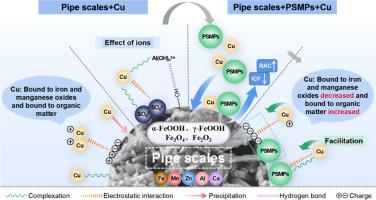当前位置:
X-MOL 学术
›
Water Res.
›
论文详情
Our official English website, www.x-mol.net, welcomes your feedback! (Note: you will need to create a separate account there.)
Cu fate driven by colloidal polystyrene microplastics with pipe scale destabilization in drinking water distribution systems
Water Research ( IF 12.8 ) Pub Date : 2024-04-13 , DOI: 10.1016/j.watres.2024.121613 Xianxian Chu , Jing Liu , Nan He , Jiaxin Li , Tiantian Li , Yimei Tian , Peng Zhao
Water Research ( IF 12.8 ) Pub Date : 2024-04-13 , DOI: 10.1016/j.watres.2024.121613 Xianxian Chu , Jing Liu , Nan He , Jiaxin Li , Tiantian Li , Yimei Tian , Peng Zhao

|
Microplastics (MPs) and Cu have been detected in drinking water distribution systems (DWDSs). Investigating MP effects on Cu adsorption by pipe scales and concomitant variations of pipe scales was critical for improving the water quality, which remained unclear to date. Therefore, polystyrene microplastics (PSMPs) were adopted for the model MPs to determine their effects on Cu fate and pipe scale stabilization, containing batch adsorption, metal speciation extraction, and Cu release experiments. Findings demonstrated that complexation and electrostatic interactions were involved in Cu adsorption on pipe scales. PSMPs contributed to Cu adsorption via increasing negative charges of pipe scales and providing additional adsorption sites for Cu, which included the carrying and component effects of free and adsorbed PSMPs, respectively. The decreased iron and manganese oxides fraction (45.57 % to 29.91 %) and increased organic fraction (48.51 % to 63.58 %) of Cu in pipe scales when PSMPs were coexisting illustrated that PSMPs had a greater affinity for Cu than pipe scales and thus influenced its mobility. Additionally, the release of Cu could be facilitated by the coexisted PSMPs, with the destabilization of pipe scales. This study was the first to exhibit that Cu fate and pipe scale stabilization were impacted by MPs, providing new insight into MP hazards in DWDSs.
中文翻译:

胶体聚苯乙烯微塑料驱动的铜命运与饮用水分配系统中管垢不稳定
在饮用水分配系统 (DWDS) 中检测到了微塑料 (MP) 和铜。研究 MP 对管垢吸附铜的影响以及随之而来的管垢变化对于改善水质至关重要,但迄今为止尚不清楚。因此,采用聚苯乙烯微塑料(PSMP)作为模型MP,以确定其对铜命运和管垢稳定性的影响,包括批量吸附、金属形态萃取和铜释放实验。研究结果表明,络合和静电相互作用参与了铜在管垢上的吸附。 PSMP 通过增加管垢的负电荷并为 Cu 提供额外的吸附位点来促进 Cu 吸附,其中分别包括游离 PSMP 和吸附 PSMP 的携带效应和组分效应。当PSMPs共存时,管垢中铁和锰的氧化物分数降低(45.57%至29.91%),而Cu的有机分数(48.51%至63.58%)增加,说明PSMPs对Cu的亲和力比管垢更大,从而影响其流动性。此外,共存的 PSMP 可能会促进 Cu 的释放,从而破坏管垢的稳定性。这项研究首次证明了 MP 影响 Cu 的命运和管垢稳定性,为 DWDS 中 MP 危害提供了新的见解。
更新日期:2024-04-13
中文翻译:

胶体聚苯乙烯微塑料驱动的铜命运与饮用水分配系统中管垢不稳定
在饮用水分配系统 (DWDS) 中检测到了微塑料 (MP) 和铜。研究 MP 对管垢吸附铜的影响以及随之而来的管垢变化对于改善水质至关重要,但迄今为止尚不清楚。因此,采用聚苯乙烯微塑料(PSMP)作为模型MP,以确定其对铜命运和管垢稳定性的影响,包括批量吸附、金属形态萃取和铜释放实验。研究结果表明,络合和静电相互作用参与了铜在管垢上的吸附。 PSMP 通过增加管垢的负电荷并为 Cu 提供额外的吸附位点来促进 Cu 吸附,其中分别包括游离 PSMP 和吸附 PSMP 的携带效应和组分效应。当PSMPs共存时,管垢中铁和锰的氧化物分数降低(45.57%至29.91%),而Cu的有机分数(48.51%至63.58%)增加,说明PSMPs对Cu的亲和力比管垢更大,从而影响其流动性。此外,共存的 PSMP 可能会促进 Cu 的释放,从而破坏管垢的稳定性。这项研究首次证明了 MP 影响 Cu 的命运和管垢稳定性,为 DWDS 中 MP 危害提供了新的见解。



























 京公网安备 11010802027423号
京公网安备 11010802027423号